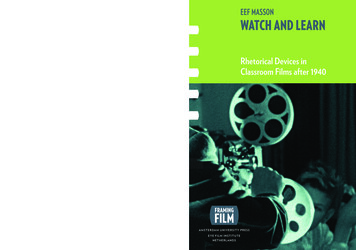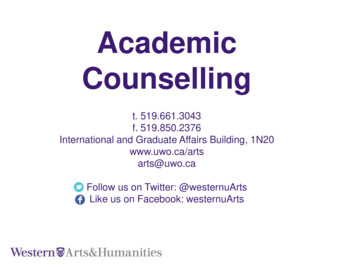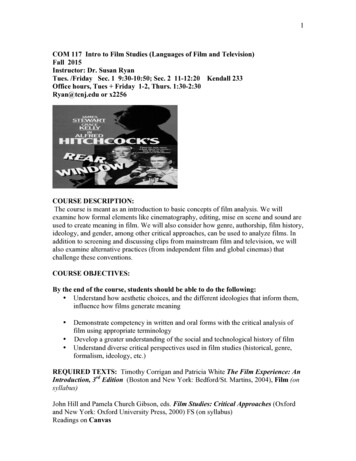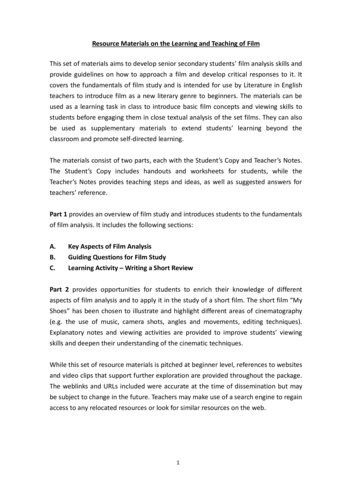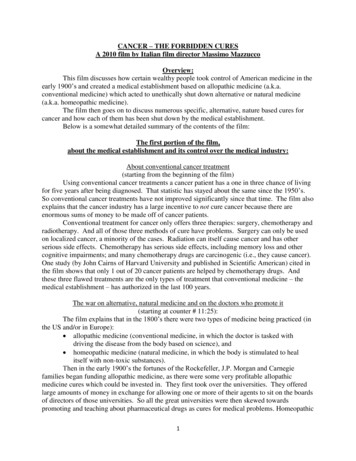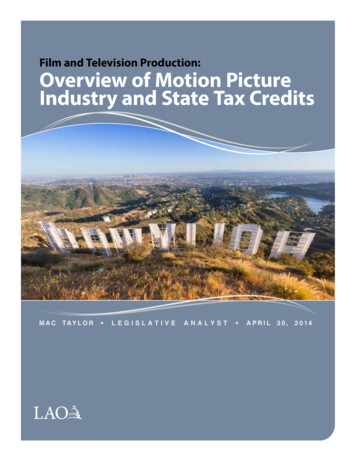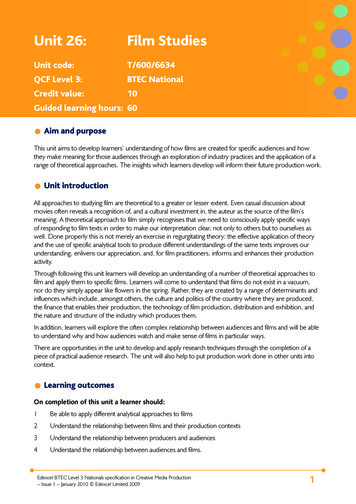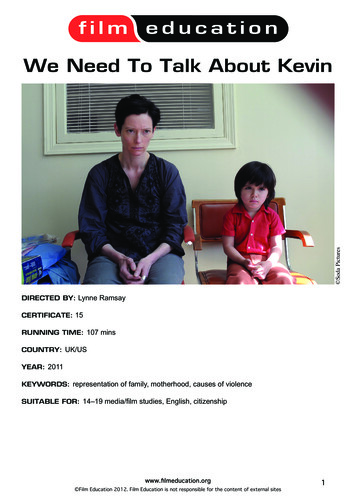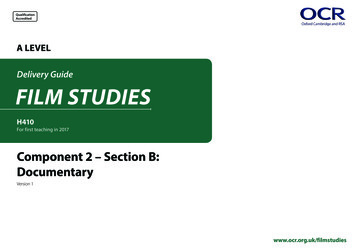
Transcription
QualificationAccreditedA LEVELDelivery GuideFILM STUDIESH410For first teaching in 2017Component 2 – Section B:DocumentaryVersion 1www.ocr.org.uk/filmstudies
IntroductionA Level Film StudiesDelivery GuideA LEVELFILM STUDIESThis guide outlines approaches and ideas, including learner activities for the Section Bof Component 2: Documentary.Delivery guides are designed to represent a body of knowledge about teaching a particulartopic and contain: Content: A clear outline of the content covered by the delivery guide; Thinking Conceptually: Expert guidance on the key concepts involved, commondifficulties students may have, approaches to teaching that can help studentsunderstand these concepts and how this topic links conceptually to other areas of thesubject; Thinking Contextually: A range of suggested teaching activities using a variety ofthemes so that different activities can be selected which best suit particular classes,learning styles or teaching approaches.If you have any feedback on this Delivery Guide or suggestions for other resources youwould like OCR to develop, please email resources.feedback@ocr.org.ukCurriculum Content3Thinking Conceptually4Thinking Contextually8Learner Resources – Activities9DISCLAIMERThis resource was designed using the most up to date information from the specification at the time it was published. Specifications are updated over time, which meansthere may be contradictions between the resource and the specification, therefore please use the information on the latest specification at all times. If you do notice adiscrepancy please contact us on the following email address: resources.feedback@ocr.org.uk2 OCR 2017
Curriculum contentA Level Film StudiesDelivery GuideA brief contextual history of documentary filmThe Documentary component is designed to engage learners in the close study ofdocumentary film. Learners are required to study documentary film and the ways in whichthis form of filmmaking uses film form, narrative and generic conventions to represent realityand create representations of societies and cultures. Learners also need to critically debatethe claims of naturalism and realism and the formalist and structuralist conception of filmnarrative in relation to documentary film.In order to evaluate how documentary film constructs meaning, learners will also need toanalyse how the social, cultural, political, historical and institutional contexts inform a widerunderstanding of this mode of filmmaking.Learners will build upon their understanding of Component 01, with particular referenceto the micro-elements of film form and the construction of meaning and response by bothfilmmaker and spectator.Learners must study one set documentary film in depth and there is a choice of six setdocumentary films. These films cover a range of different stylistic and aesthetic approachesand draw from the different modes of documentary.Finally learners are required to study the significance of the following two, contrastingfilmmakers’ theories of film in relation to the set documentary film they study: John Grierson D.A. Pennebaker.As a summary assessment of this section and questions will focus on: Representations (how they are constructed through film form, narrative and the genericconventions of documentary filmmaking) Contexts Spectatorship.Critical debates on: Representations of reality and claims of naturalism and realism Film narrative Filmmakers’ theories of film.3 OCR 2017
Thinking conceptuallyA Level Film StudiesDelivery GuideApproaches to teaching the contentGeneral approachesAs with fiction film, documentary films will use a set of established techniques whichallow the spectator to make sense of what they are watching. Unlike fiction film, wherethe classification is through genre, it is beneficial for the spectator to consider the‘mode’ of documentary instead; this is due to the wide ranging subject areas covered bydocumentary films as well as the approach the filmmaker has taken being more useful tothe spectator in understanding the film.As technology improved and both sound and camera kit got smaller and lighter it becamepossible to for a reduction in the number of people needed in a film crew. In the 1960sit was possible to use a small 16mm handheld synch camera to film on location andwith minimal crew members. The filmmakers of the French New Wave had also takenadvantage of the new lighter weight kit to make their films.This technological shift allowed documentary filmmakers to produce more observational‘fly on the wall’ work that later became known as ‘Direct Cinema’. From the 1960s onwardsfilmmakers begun to mix styles to suit their needs and aesthetic. Contemporarydocumentaries have adopted a much more fluid approach to their construction,borrowing techniques and styles from a range of film genres and forms including largebudget Hollywood productions to animations.The mode of documentary will motivate the ‘story’ and the way the narrative isconstructed. The mode will also dictate how obvious the narrative is and how active thespectator will need to be in making sense of it. For example a documentary which usesthe poetic mode will place less emphasis on narrative structure and continuity editing willbe less important; this would contrast with a film using the expository mode where thenarrative structure will be very clear and the spectator will be on a much more fixed routethrough the film. Less will be left for the spectator to make up their own mind about.Given the contemporary nature of the set documentary films then rather than approachthe classification of documentary film based on technology used it is possible to base iton content and mode of address.We can also use indicate the way in which, through the choice of mode and editing,spectators are encouraged to adopt the position and outlook of the filmmaker andwill potentially align themselves with the point of view being expressed within thedocumentary. Arguably this adoption of a point of view by the spectator is more explicit indocumentary due to its very specific focus on ‘actuality’.Modes of documentary filmmakingIn his book ‘Introduction to Documentary’1 Bill Nichols proposes six different modes ofdocumentary filmmaking. These are as follows:Contextual history of documentary filmmakingPoetic modeAs with fictional film a loose history of development can be identified within westerndocumentary filmmaking. This is aligned to technological developments and the impactthat they had on the production of documentary films.Films made in this mode tend to focus more on the aesthetic elements and are interestedin reflecting tone and mood as opposed to imposing a narrative structure on the content.Individual characters and their viewpoints and stories are not developed. The rhetoricalelement found in other modes of documentary remains underdeveloped. Films made inthis mode can often be considered ‘avant-garde’ due to the structure and presentation ofcontent.The pre-documentary phase begins in 1895 with L’arriveé d’un train en gare de La Ciotat(Arrival of the train at Ciotat Station). This was a simple static camera filming a ‘real’ event.Expository modeThe next step forward was in 1922 with Nanook of the North (Flaherty) which can beconsidered the first classic silent documentary. As with fiction films synchronous soundbegan to appear in documentary films during the 1930s, Housing Problems can beconsidered as a key example of this. The advent of synchronous sound presentedtechnical problems to documentary films as the cost and the size of the equipment bothcaused difficulties. During this period sound was often voice over narration, music andsound effects. This partly accounts for the often omniscient narration in documentariesfrom this period.In contrast to the Poetic mode this mode is much more structured, often employing a‘voice of God’ or authoritative narration to guide the spectator through the narrativestructure and focus on a particular point of view. Unlike poetic mode, images in this modeof documentary serve to support and illustrate the narration; the narration is to help thespectator make sense of what they are seeing and why.14Nicols, B. (2001) Introduction to Documentary. Indiana University Press. ISBN: 978-0253214690 OCR 2017
Thinking conceptuallyA Level Film StudiesDelivery GuideObservational modeDocumentary as textThe primary aspect of this mode of documentary is that the filmmaker is observing whatis happening in front of the camera without any intervention. Unlike the poetic and theexpository there is often no music, no scene arrangement, no interviews and no narration.As spectators we are meant to witness what the filmmaker is seeing and at the sametime have greater agency in determining what is significant in the film or not. It can beconsidered to be a ‘fly on the wall’ approach to making documentaries.Whilst documentary film does not fit easily into the same genre categories used by fictionfilm, it does rely heavily on the language and grammar used in fictional filmmaking; thereis no alternative film language specifically for documentary. This adoption of fictional filmgrammar has resulted in ‘mainstream’ conventions being applied to documentary film andhave allowed spectators to ‘read’ documentary films and make sense of them. Techniquessuch as cross-cutting, sound effects, voiceover, music and stylised reconstructions are allused in documentary films. At face value the use of cinematic techniques can appear atodds with a film which is dealing with real events and real people. Arguably though, itfits with Grierson’s definition of documentary as ‘the creative treatment of actuality’. The‘actuality’ of documentary has always been subject to ‘creative treatment’ through theneed to construct a narrative, through manipulation during editing, for example or in earlydocumentaries, the need for scenes to be reshot so that the synch sound would work.Reconstructions have always been part of the ‘creative treatment’ from Nanook of the Northonwards and whilst this technique was avoided in Direct Cinema there was still a need forfilms made in this style to create narrative coherence.Participatory modeIn this mode the visibility of the relationship between the filmmaker and the subject ispresent and not hidden. This can range from hearing the filmmaker asking questions toappearing on screen with the subjects. This mode should allow us as spectators to gain asense of what it is like for the filmmaker to be in a particular situation.Reflexive modeThis mode allows the filmmaker to engage with the spectator and draws attention to theconstruction of the documentary itself. This mode is the most self-aware and also the mostself-questioning of the documentary modes and will force the spectator to question theirrelation to what is being presented on screen and the manner in which it is being done.The micro-elements of film form therefore can be seen to underpin documentary filmas well. Cinematography, mise-en-scène, editing, sound and performance are usedby documentary filmmakers to help shape and direct both narrative structure andrepresentations in their films. In the documentary films chosen for close study it is possibleto see how these techniques can be used. Man on Wire (Marsh 2008) focuses on the storyof Philippe Petit and his wire walk between the Twin Towers of the World Trade Centerin 1974. In telling this ‘story’ it blends archive footage, still photographs and talking headinterviews alongside reconstructions which themselves resemble sequences from a thrillerfilm. Throughout the film a non-diegetic soundtrack is also used to enhance spectatorresponse and generate meaning.Performative modeUnlike the participatory mode the performative mode is less about the filmmaker beinginvolved with the subject as it is about the subject making the film. Nichols identifies itas ‘we speak about ourselves to you’ or even ‘we speak about ourselves to us’; essentiallythis is about more than just documenting facts and events but as much about addingsubjective qualities surrounding the filmmaker or subjects’ own experiences.These modes provide a useful starting point for thinking about documentary filmand classifying it in a more structured way than just genre terms. It presents a criticalframework for considering how a film can be ‘read’ by a spectator rather than trying toplace it into a historical continuum.The use of reconstructions is also evident in The Act of Killing (Oppenheimer 2012) whichfocuses on a number of individuals who participated in mass killings in Indonesia in1965-66. The reconstructions borrow from fictional genres to reconstruct memories;Oppenheimer refers to the film as a ‘documentary of the imagination’ which signifies ashift away from both the Grierson and Direct Cinema approach. This also allows for a morecreative approach to the way in which a documentary can tell a story or deal with the ideaof ‘truth’.The six documentary set films for this component are:The Stories We Tell (2013). Directed by Sarah Polley, 12Searching for Sugarman (2012). Directed by Malik Bendjelloul, 125 Broken Cameras (2011). Directed by Emad Burnat, Guy Davidi. 15The Act of Killing (2012). Directed by Joshua Oppenheimer, 15Man on Wire (2008). Directed by James Marsh, 12Citizenfour (2014). Directed by Laura Poitras, 15Whilst very different in terms of content and tone The Stories We Tell (Polley 2013) also playswith the idea of memory and its unreliable nature. The film mixes interviews with familyand friends, narration from her ‘father’, archive footage and reconstructions shot on Super 8which are made to look like archive family film. This use of a variety of techniques is vitalto how the filmmaker wishes to construct the narrative and how to represent her family,both collectively and individually.5 OCR 2017
Thinking conceptuallyA Level Film StudiesDelivery Guide5 Broken Cameras (Burnat and David 2011) is also a personal story which uses observationalfootage shot by Emad Burnat with added narration to help guide the spectator. The film usesa diary style narrative structure with each section linked to one of the five broken cameras.The use of this diary structure device helps to shape the narrative, as the film becomes ajourney from the personal to the political. Searching for Sugarman (Bendjelloul 2012) alsouses a journey structure to shape its narrative, following two fans as they search for SixtoRodriguez. Mixing archive footage and talking head interviews with other footage shoton Super 8 the filmmaker has made an aesthetic decision in how the overall film will lookand how micro-elements such as sound will be used to enhance the emotion within thestory. In dealing with a more serious and overtly political topic Citizenfour (Portias 2014) usea mix of interviews, narration and screen based communications to tell the story of bothEdward Snowden and the NSA surveillance program. The use of tightly framed shots helpto signify Edward Snowden as a trapped political agent, this is supported by a non-diegeticsoundtrack which helps to create tension and enhance the atmosphere for the spectator.potentially be an agent for facilitating social, cultural and political developments throughthe representation and re-construction of historical issues and events. This can also beapplied to 5 Broken Cameras which deals with political issues within in Palestine and Israelbut does so primarily through the experiences of one man and his family.A family based focus is also central to The Stories We Tell which is an example of how a filmcan act as a means of constructing social and cultural attitudes toward wider issues andbeliefs due to the topics and experiences which are explored within the films narrative,characterisation and representations. In contrast to this Citizenfour deals with much morecontemporary issues and can be seen as a film which reflects and comments on currentsocial, cultural and political attitudes all of which are explored within the films narrativeand representations, both of individuals and institutions.Given the smaller audiences which documentary films attract all of the set films reflectproduction, financial and technological opportunities and constraints. This varies betweenfilms and on both the aesthetic and technical choices that have been made duringproduction; from shooting on Super 8 to the need to travel with minimal equipment.Arguably the most important micro-element in constructing the documentary’s story andnarrative is editing. How the filmmaker chooses to show the spectator information andthe order in which this is presented is key. This is where the story will start to make senseand where pacing and story structure become vital in communicating the films messagesand values. It is important to be aware that no documentary will be completely neutral;even one which is primarily observational such as 5 Broken Cameras ultimately becomesmore political and polemical.As filmmakers, John Grierson and D.A. Pennebaker can be seen to represent two verydifferent schools of thought within documentary filmmaking and they also have anaccessible body of work and writings and interviews about documentary filmmaking.Unlike an academic writing about film, their writing and interviews often reflect upon theirown practice and position rather than offer a specific theory.Documentary and wider meaningGrierson can be arguably be seen as the founding member of the Documentary FilmMovement, a movement which should use cinematic means to draw attention to the roleof individuals within society and promote a set of values including the heroism of ordinarypeople, the mixing of social classes and the individual’s role as part of a wider collective.The first film produced by Grierson which built on these values was Drifters (1929), whichproved to be a critical, and a commercial success - it was produced by the EMB (EmpireMarketing Board) and is on the surface a short film about the herring industry. From thisthe key period for the production of documentary films that aligned themselves withGrierson’s ideas about what a documentary should be was from 1930-1952 during whichtime a significant number of socially focused documentaries were produced. Griersonwas instrumental in developing the idea about what type of documentary should beproduced and its wider role in society but he was not the only filmmaker to be part of thewider movement. Other key figures include Humphrey Jennings, Basil Wright and AlbertoCavalcanti all of whom made significant films during this period.All filmmaking is influenced by a range of wider factors including social, cultural, political,historical and institutional contexts in which the film is produced, distributed and viewed.Documentary film is perhaps more explicit in reflecting some of these contexts and allof the set films do this to varying extents. All of the films apart from Citizenfour reflecton events which are historical at the time of production: Man on Wire examines anddocuments an event which took place in 1974; The Act of Killing covers events whichoccurred in 1965-66; Searching for Sugarman deals with a recording artist who prior tothe film last released an album in 1971 and The Stories We Tell deals with an individual’spast. This reflection on the past and framing the story around historical events can allowdocumentary to comment on contemporary issues and reframe past events within acurrent social, cultural and political context. Man on Wire was released in 2008, seven yearsafter 9/11 but this event is never mentioned in the film even in contemporary interviewswith the key protagonists, and arguably this deliberate omission makes the film morepoignant as it reflects on a time and place which no longer exist. Equally, Searching forSugarman covers a period of major political and social change within South Africa anduses the narrative device of searching for a singer to cover a wider range of issues. The Actof Killing deals with historical political issues but in a contemporary context forcing thespectator to reflect on these issues now. It is a good example of how a film canIn contrast to Grierson, D.A. Pennebaker began his career in the 1960s and at a timewhen filmmaking technology had improved, was much lighter and now fully portable.Alongside this there was a reaction to the way documentary films had previously been6 OCR 2017
Thinking conceptuallyA Level Film StudiesDelivery Guidemade and the lack of authenticity which resulted in a movement known as Direct Cinema.Pennebaker was a member of ‘Drew Associates’ and involved in Primary (1960) whichfollowed a young John Kennedy as he ran for election. From this he begun to make filmswhich he felt fitted better with his view about what Direct Cinema should be. This wasperhaps realised with Don’t Look Back (1965), his film which followed Bob Dylan on his finalacoustic tour of Britain. It is feature length and voiceover free and offers a marked changefrom what a documentary could be and what it could look like. The lasting influence ofDirect Cinema on documentary is perhaps its aesthetic which is evident in the use ofhandheld camera moves and a ‘gritty’ and ‘real’ look.Common misconceptions or difficulties learners may haveIt is important for learners to be clear about what a documentary film is and thedifferences between this and fiction films based on real events. There is often confusionwith biopics and other films based on true stories.It is also important that learners are aware that the films studied were releasedcinematically and that there is a difference between a documentary on TV and onereleased in a cinema even if it subsequently gets a TV screening.With this topic there is likely to be some concern over the role of filmmakers as theorists.Rather than search for a set theory, it is more of a summary of the filmmaker’s view ofhow a documentary can be made and their approach to making a documentary. Thisrepresents a subtle shift away from theory being more academically based.Conceptual links to other areas of the specification – useful ways to approach thistopic to set learners up for topics later in the courseThe study of documentary film draws upon and develops learning from the whole courseand will include but not be limited to: an understanding of the micro-elements of filmform (Cinematography, mise-en-scène, editing, sound performance); how narrative andgeneric conventions of documentary film contribute to the ways in which documentaryfilm represents reality and creates representations of societies and cultures; the claims ofnaturalism and realism and the formalist and structuralist conception of film narrative inrelation to documentary film.Learners will also study the contextual framework of the documentary film with aconsideration of how the social, cultural, political, historical and institutional contextsinform analysis and understanding of this mode of filmmaking.7 OCR 2017
Thinking contextuallyA Level Film StudiesDelivery GuideApproaches to teaching the contentThis delivery guide provides a range of learning opportunities that encourage a varietyof approaches to the study of documentary film and can be applied to any of the six setfilms. These range from practising textual analysis of how documentary films constructand represent reality, to considering the viewpoints of the theorists (Grierson andPennebaker) in relation to the set texts, to creative exercises that allow learners to explorehow to present a particular viewpoint.8 OCR 2017
Learner Resources – ActivitiesA Level Film StudiesDelivery GuideLearner Activity 1Filmmaker as theoristLearners should have knowledge of John Grierson and D.A. Pennebaker and their views ondocumentary filmmaking. To introduce learners to this ask them to complete a fact file. Thiscan be referred to as the topic is explored further and linked directly to the film studied.Below are links for each filmmaker to get you started.BooksThis is by no means exhaustive and where possible it would be useful to supplement thiswith relevant books, suggestions are listed below as well. You could ask learners to researchone aspect and present it to the rest of the class. You could also have the class debate thediffering views and see which viewpoint is most relevant to the film that they have studied.John Grierson (links) n.html - Grierson Trust articles/john-grierson-n-pronay.pdf ) http://libguides.stir.ac.uk/archives/Grierson - Archive of Grierson’s work at theUniversity of Stirling http://www.bbc.co.uk/programmes/b012p53d - BBC 4 Documentary Britain Througha Lens: The Documentary Film Mob available online (https://www.youtube.com/watch?v v6fWe0tpSSg) http://www.bbc.co.uk/programmes/b042rlbv - BBC 2 Documentary DocumentingJohn Grierson available online (https://www.youtube.com/watch?v UQir- RxlZ0) https://en.wikipedia.org/wiki/John Grierson - Wikipedia page ‘On Documentary’ John Grierson (Faber and Faber 1979) ISBN: 0571113672 n/dp/0571113672) D. A. Pennebaker: Interviews (Conversations with Filmmakers Series) (University Pressof Mississippi 2015) ISBN: 1628462027 onversations-Filmmakers-ebook/dp/B01C90QYE4) Imagining Reality: The Faber Book of Documentary Edited by Mark Cousins and KevinMacdonald (Faber and Faber 2006) ISBN: 0571225144 (https://www.amazon.co.uk/dp/B0056HIOFU/ref dp-kindle-redirect? encoding UTF8&btkr 1) The Documentary Film Book Edited by Brian Winston (British Film Institute 2013) ISBN:1844573419 ian-Winston/dp/1844573419)John Grierson (right)examining wartimedocumentary postersD.A. Pennebaker (links) https://en.wikipedia.org/wiki/D. A. Pennebaker - Wikipedia page nebaker-looks-back - interview with Sight and Soundmagazine e-cage - interview with POV magazine find-the-truth-in-people-510386/ - good article onPennebaker from Indiewire online magazine http://phfilms.com/history/ - D.A. Pennebaker’s production company https://www.youtube.com/watch?v wii6fDmv50E - Interview with D.A. Pennebaker https://vimeo.com/21664518 - Greil Marcus interviews D.A. Pennebaker about filmingBob Dylan9 OCR 2017
Learner Resources – ActivitiesA Level Film StudiesDelivery GuideViewing activitiesLearner Activity 3Analysing key scenesIdentify how the micro-elements of film form are used to construct the structural elementsof documentary film. This will mean close textual analysis of specific sequences andconsidering how they link to wider elements of the film.Watch the chosen film through. Learners should make notes as they watch the film – thesecan be used during the following tasks. Personal response is important. Learners shouldunderstand that their personal interpretation is valid and will feed into their comments onwider issues.Learner Activity 2Identifying and understanding structural elements of filmThese tasks will enable learners to identify how structural elements are used to generatespectator response and how documentary film uses elements from fiction film.1.Using the following information help introduce learners to the different modes ofdocumentary x-primary-styles-of-documentaryproduction2.With the help of a copy of the synopsis, ask learners to identify which mode ormodes of documentary they think the focus film fits. Learners should identify specificsequences that they think illustrate this.3.Having watched the film learners should investigate how the films narrative isstructured. Could the films narrative fit into a model for fiction films? Does it use asimilar three act structure? The following articles help explain what this is and how 05/Learners should use the following worksheet to try and map out the film and tosee if it uses a conventional narrative structure adigm.pdfIf not in what ways is it different? Could you restructure the film so that it followed aconventional narrative structure?4.Possible questions to consider: How are you positioned as a spectator? Can the documentary be trusted? How reliable is the narration? Does it reflect theactual events? How has the film been edited? What techniques have been used to tell the story? Have reconstructions beenused? Have talking head interviews been used? What impact do these have on thespectator? How is sound used? Is non-diegetic sound used, If so how? How are characters framed? How is cinematography used to tell the story?Learner Activity 4Beyond the textAsk learners to investigate the social, economic, political, historical and institutional contextfor the focus film. If so in what ways does it do this? You could use collaborative tools suchas Google drive, or Microsoft Onedrive to produce a whole class learner resource. It wouldbe useful for learners to identify specific scenes which they think illustrate their points.Possible questions to consider: What impact has social, economic or political factors had on the films production? Does the film represent a particular political viewpoint? If so what is this and how is itevident? Does the film construct a particular viewpoint ba
this form of filmmaking uses film form, narrative and generic conventions to represent reality and create representations of societies and cultures. Learners also need to critically debate the claims of naturalism and realism and the formalist and structuralist conception of film narrative in relation to documentary film.
